Calculations involving Circuits
E.g.1
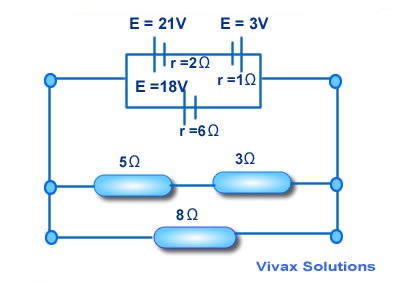
Calculate the terminal potential difference across each cell in the above circuit.
Total EMF of the top two cells = 21-3 = 18V
Since they are in parallel with the bottom cell, Total EMF = 18V
Total internal resistance of the top two cells = 1 + 2 = 3Ω
Total internal resistance of the three cells, 1/r = 1/3 + 1/6
r = 2Ω
Total resistance of the top branch = 5 + 3 = 8Ω
Total resistance of the resistors, 1/R = 1/8 + 1/ 8 = 2 /8 = 1/4
R = 4Ω
So, the total resistance of the circuit= 6Ω
If the total current is I, I = 18/6 = 3A
Let the currents through the top branch of cells is a and that of the bottom branch be b
a + b = 3; 3a = 6b => a = 2b
3b = 3 => b = 1A; a = 2A
Since Vt = E - Ir
For the first cell, Vt = 21 - 2x2 = 17V
For the second cell, Vt = 3 -(-2)x1 = 5V - the current flows in the opposite direction in this cell
For the third cell, Vt = 18 - 1x6 = 12V.
E.g.2
Find the terminal potential difference across the cell.
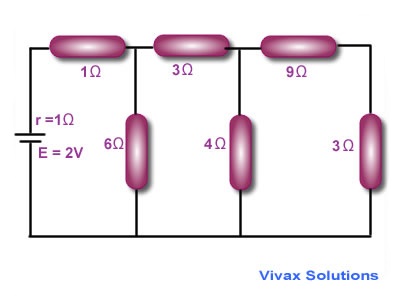
Total resistance of the last three resistors, 1/R = 1/4 + 1/(9 + 3) = 1/3 => R = 3Ω
Total resistance of 6&Omega, 3Ω and 3Ω, 1/R = 1/6 + 1/(3+3) = 2/6 = 1/3 => R = 3Ω
Total resistance of the circuit = 1 + 1 + 3 = 5Ω
Total Current, I = 2/5 = 0.4A
So, Vt = E - Ir = 2 - .4x1 = 1.6V.
E.g.3
If two resistors, 6Ω and 3Ω, are connected in series with a cell, the current through the circuit is 2A. If the two are connected in parallel with the cell, the current is 6A. Find the EMF and r of the cell.
When the resistors are in series, R = 6 + 3 = 9Ω
So, the total resistance = 9 + r
Total current, 2 = E/(9 + r) => E = 18 + 2r
When the resistors are in parallel, 1/R = 1/6 + 1/ 3 = 3/6 = 1/2 => R = 2Ω
So, the total resistance = 2 + r
Total current, 6 = E/(2+r) => E = 12 + 6r
So, 12 + 6r = 18 + 2r
4r = 6 => r =1.5A
E = 18 + 2X1.5 = 21V.
E.g.4
Three bulbs of the same power and voltage are connected to a battery with negligible internal resistance in a circuit as follows. If the bulb B burns out, what will happen to the brightness of bulb A?
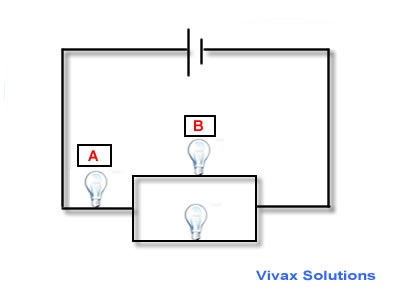
If the bulb B burns out, the total resistance of the circuit goes up - from 3R/2 to 2R, where R is the resistance of each bulb.
So, the current goes down. That means the brightness of bulb A goes down as well - P = VI = I2R; R is the same and I goes down.
E.g.5
There are 24 bulbs in a Christmas lighting set which is rated as 20W, 240V. If four bulbs were removed and short-circuited, what would be the new power of the light set?
The power of each bulb = 20/24 = 5/6Watts
The voltage across each bulb = 240/24 = 10V
Since P=VI, the current through each = (5/6)/10 = 1/12A
V = IR => 10 = (1/12)R => R = 120Ω
After short-circuiting, there are only 20bulbs. So, the new voltage for each goes up to 12V.
Total resistance = 20 x 120 = 2400Ω
New current, I = V/R = 240/2400 = 1/10A
New power of each bulb, P = VI = 12 X (1/10) = 1.2Watts
So, the bulbs would light up more brightly.
E.g.6
Two light bulbs are rated 12W, 20V. When they are connected to a power source in parallel, they light up normally. What would happen, if they were connected to the same power source in series?
If they light up normally, each bulb must be getting a voltage of 20V.
P = VI => 12 = 20I => I = 3/5 = 0.6A
V = IR => 20 = 0.6R => R = 100/3Ω
If they are connected in series, the total resistance = 200/3Ω
The new current I = 20/(200/3) = 60/200 = 0.3A
Since the voltage is split up between the two,
New Power, P = VI = 10 x .3 = 3Watts
So, the bulbs would get dimmer, when connected in series.
E.g.7
Find the voltages across 3Ω and 12Ω resistors.
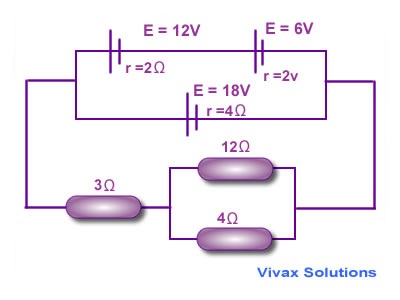
Total resistance of 12Ω and 4Ω, 1/R = 1/12 + 1/4 = 4/12 => R = 3Ω
So, the total external resistance = 3 + 3 = 6Ω
Total internal resistance of the cells, 1/r = 1/(2+2) + 1/4 = 2/4 = 1/2 => r = 2Ω
Total resistance of the circuit = 8Ω
Total EMF = 18V
Total current, I = 18/8 = 2.25A
So, the voltage across 3Ω, V = IR = 3 X 2.25 = 6.75V
This current splits up between the 12Ω and 4Ω. If they are a and b respectively,
a + b = 2.25
Moreover, 12a = 4b - the resistors are in parallel.
b=3a => 4a = 2.25 => a = 0.5625A
Therefore, the voltage across 12Ω = 12 * 0.5625 = 6.75V.
Interactive Practice
With the following applet, you can practise circuit question interactively. You can change the values of four resistors and then see how the total current and voltage across the fourth resistor changes.
You are recommended to do the calculations manually first and then use the programme for checking - to get a good practice on the concepts.
Challenge:
If the bulb A burns out, what will happen to the other two in terms of brightness?
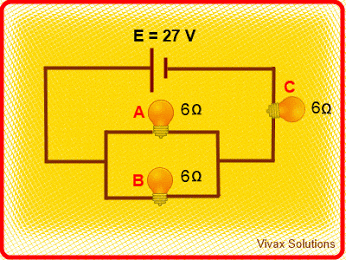
Answer: Move the mouse over here: Both B and C will get dimmer.
Finding the EMF and the internal resistance of a cell
Change the resistance of the variable resistor while measuring the current and the voltage.
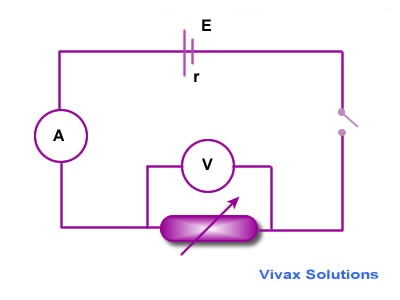
Then plot a graph of V against I. r and EMF can be found from the graph.
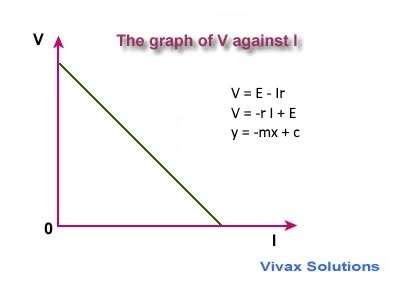
The gradient and the intercept give us the required values.
m = -r; c = E.
Potential Dividers
When two or more resistors are connected in series across a certain voltage, they split up the voltage into smaller units. So, such an arrangement can be used as a
potential divider.
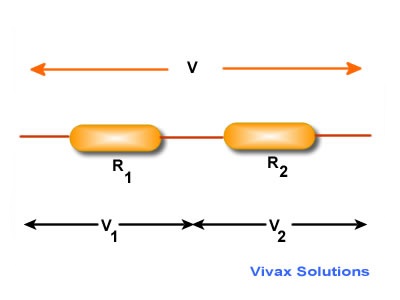
Total resistance = R1 + R2
Total current = V/(R1 + R2)
Voltage across R1 = VR1/(R1 + R2)
Voltage across R2 = VR2/(R1 + R2)
So, two different smaller voltages can be obtained across R1 and R2 respectively. This is the basis of a potential divider.
E.g.1
Two resistors of 12Ω and 6Ω are connected across 72V. Find the voltages across the individual resistors.
Total resistance = 12 + 6 = 18Ω
Total current = 72/18 = 4A
Voltage across 12Ω = 4x12 = 48V
Voltage across 6Ω = 4x6 = 24V.
E.g.2
A resistor of 12Ω and RΩ are connected across a voltage of 60V. Find the value of R, if a voltage of 24 must be obtained across it.
Total resistance = (12 + R)Ω
Total current = 60/(12 + R)
Voltage across 12Ω = 60 - 24 = 36V
Current through 12Ω = 36/12 = 3A
Voltage across RΩ = 24V
Since the current is the same,
R = V/I = 24/3 = 8Ω.
Use of Potential Dividers
1) LDR triggering off a burglar alarm
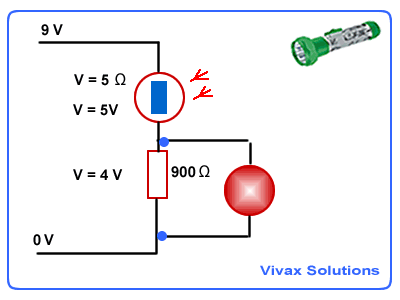
An LDR - light dependent resistor - reacts to the amount of light that falls on it. The greater the intensity, the smaller its resistance becomes. As resistance goes down, so does the voltage across it - V = IR. So, the voltage across 900Ω resistor goes up, as the total voltage remains constant at 9V. When this happens,
the alarm which is connected across it goes off. In short, when a burglar lights up the LDR, it triggers off the alarm - much to his shock, of course.
2) Thermistor triggering off a fire alarm
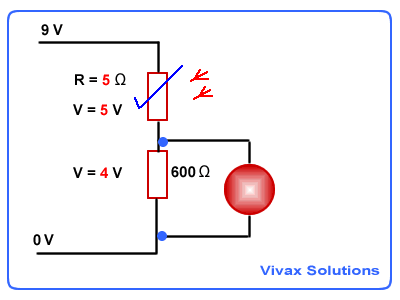
A thermistor reacts to the amount of heat that falls on it. The greater the intensity, the smaller its resistance becomes. As resistance goes down, so does the voltage across it - V = IR. So, the voltage across 600Ω resistor goes up, as the total voltage remains constant at 9V. When this happens,
the alarm which is connected across it goes off. In short, in the event of a fire, the alarm goes off.
3) A circular potentiometer
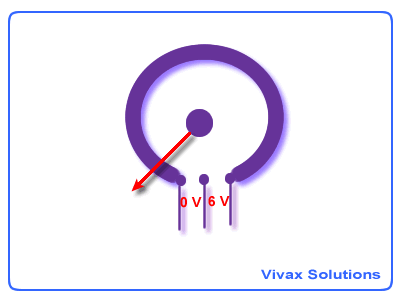
As the central shaft moves clockwise, the voltage between the centre and both ends changes - when the left goes up, right goes down and vice versa.
Next
Previous